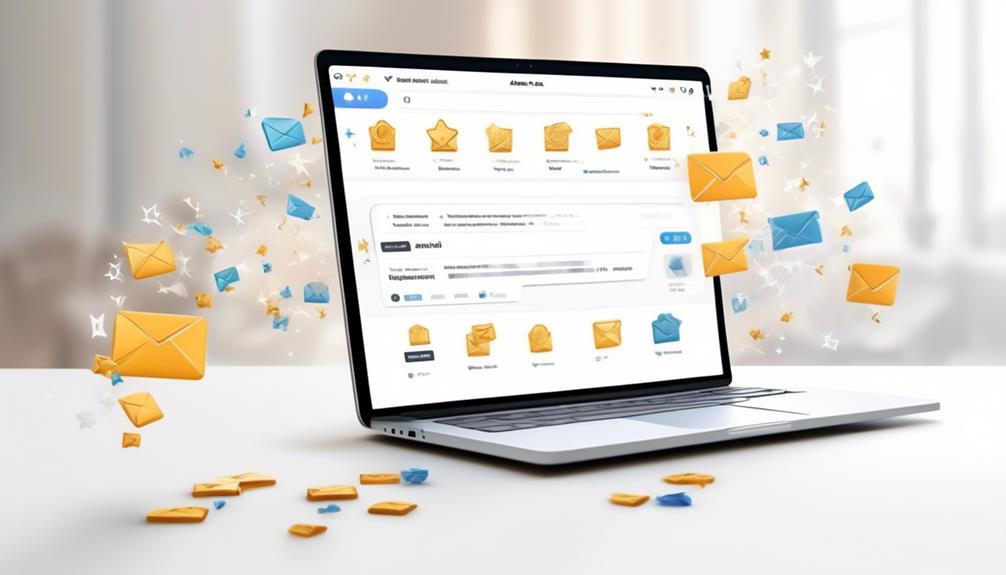It’s a well-known fact that personalized emails can boost open rates by 29% and result in a 41% greater click-through rate, but have you ever considered why personalization is so essential for the effectiveness of emails?
The impact of tailoring content to individual recipients goes beyond just addressing them by name. It's about creating a connection that resonates with the reader, ultimately driving engagement and conversions.
So, what does personalization really mean for email success rates? Let's explore the deeper significance and practical strategies behind this essential element of effective email marketing.
Key Takeaways
- Email personalization is crucial in the competitive email marketing landscape, as it significantly impacts open rates, click-through rates, and engagement.
- Personalized emails grab attention, make recipients feel valued, and encourage engagement, leading to higher conversion rates and overall business success.
- Strategies for personalizing emails include utilizing the recipient's name, segmenting email lists based on demographics and the buyer's journey, and implementing dynamic content insertion based on recipient data.
- Data plays a crucial role in email personalization by allowing businesses to create highly effective campaigns, understand customer preferences, deliver relevant content, and achieve higher engagement and conversion rates through segmentation.
Definition of Email Personalization
Email personalization is the practice of tailoring the content and delivery of emails to individual recipients based on their personal information or behavior. This involves using the recipient's name, segmenting email lists, and sending timely and relevant content to engage the audience. Dynamic content insertion, customized subject lines, and segmentation based on demographics are key techniques in email personalization. By collecting relevant data and using personalization features in email marketing platforms, businesses can continually refine their personalization techniques.
Implementing best practices for personalization can help re-engage inactive customers, increase open and click-through rates, and improve overall subscriber relationships.
Personalization in email marketing has become a crucial strategy to stand out in crowded inboxes. Research shows that personalized subject lines can increase open rates by 50%, while personalized emails can deliver 6x higher transaction rates. By understanding the definition of email personalization and implementing best practices, businesses can harness its potential to create more impactful and engaging email marketing campaigns.
Importance of Personalization

Importance of personalization can't be overstated in today's competitive email marketing landscape, where capturing attention and driving engagement are paramount to campaign success. Personalized emails have been proven to significantly impact open rates, click-through rates, and overall engagement. Implementing personalization strategies such as using the recipient's name, segmenting email lists, and sending timely, relevant campaigns can make a substantial difference in the effectiveness of an email marketing strategy.
Customized subject lines and tailored content also play a crucial role in grabbing the recipient's attention and driving higher engagement rates.
Moreover, personalization has a direct impact on conversion rates, as it creates a more personalized and meaningful experience for the recipient, leading to increased likelihood of conversion. Utilizing dynamic content insertion, demographic segmentation, and automation tactics can further enhance the personalization of emails and contribute to improved conversion rates.
In today's digital age, personalization isn't just a bonus but a necessity for successful email marketing. It's essential to continuously refine personalization techniques, collect relevant data, and analyze results to ensure that personalization efforts are effective and yield the desired outcomes.
Benefits of Personalized Emails
We've all experienced the power of personalized emails – they grab our attention, make us feel valued, and encourage us to engage.
With improved open rates and increased engagement, personalized emails have become a game-changer in the world of digital marketing.
Not only do they enhance the customer experience, but they also lead to higher conversion rates and ultimately contribute to the success of businesses.
Increased Engagement Through Personalization
Increased engagement through personalization is a crucial element in driving higher open rates, click-through rates, and overall customer engagement in email marketing. Personalized emails can significantly enhance customer interaction and response.
Here's how:
- Tailored subject lines and content grab attention and encourage interaction.
- Segmented campaigns ensure that messages resonate with specific audience segments.
- Adding a personal touch makes recipients feel valued, leading to increased trust and brand loyalty.
Improved Open Rates
After understanding the impact of personalized emails on customer interaction and response, let's now explore how this personalization directly contributes to improved open rates.
Personalized emails have a significant impact on open rates, as they capture the recipient's attention and boost engagement. By utilizing segmentation and personalization techniques, businesses can tailor their emails to specific demographics and buyer's journey, leading to higher open and click rates.
Customized subject lines and dynamic content insertion based on recipient data are also effective strategies to improve open rates. Furthermore, tailoring content for individual needs and preferences not only increases click rates but also prevents customer loss.
Ultimately, the improved open rates resulting from personalized emails can significantly contribute to higher engagement, improved conversion, and overall email marketing success.
Enhanced Customer Experience
Enhancing the customer experience through personalized emails involves utilizing the recipient's name, segmenting email lists, sending timely content, and adding a human touch to create a more engaging and impactful interaction.
Personalized emails capture the recipient's attention, increasing open rates, boosting engagement, and preventing customer loss. Dynamic content insertion, customized subject lines, and tailored content contribute to improved conversion rates through email personalization.
Best practices for personalization involve collecting relevant data, using an email marketing platform with personalization features, and continually refining personalization techniques.
Personalized product recommendations, customer engagement, and personalized experiences all play crucial roles in creating an enhanced customer experience.
Types of Email Personalization

Email personalization encompasses a variety of techniques that allow marketers to tailor their messages to individual recipients, resulting in higher engagement and conversion rates. One of the most common types of email personalization is the use of personalized emails, which involves dynamic content insertion based on recipient data. This can include customized subject lines with personal details, such as the recipient's name, which has been shown to significantly increase open rates.
Another type of email personalization involves segmenting the email list into smaller, highly personalized groups based on demographics, behaviors, or preferences. This allows for targeted and relevant content to be delivered to specific audience segments, resulting in improved engagement and conversion rates.
Furthermore, highly personalized emails go beyond just including the recipient's name. They involve tailoring the content to specific needs and preferences, ensuring that the information provided isn't only relevant but also valuable to the recipient.
Best Practices for Personalization
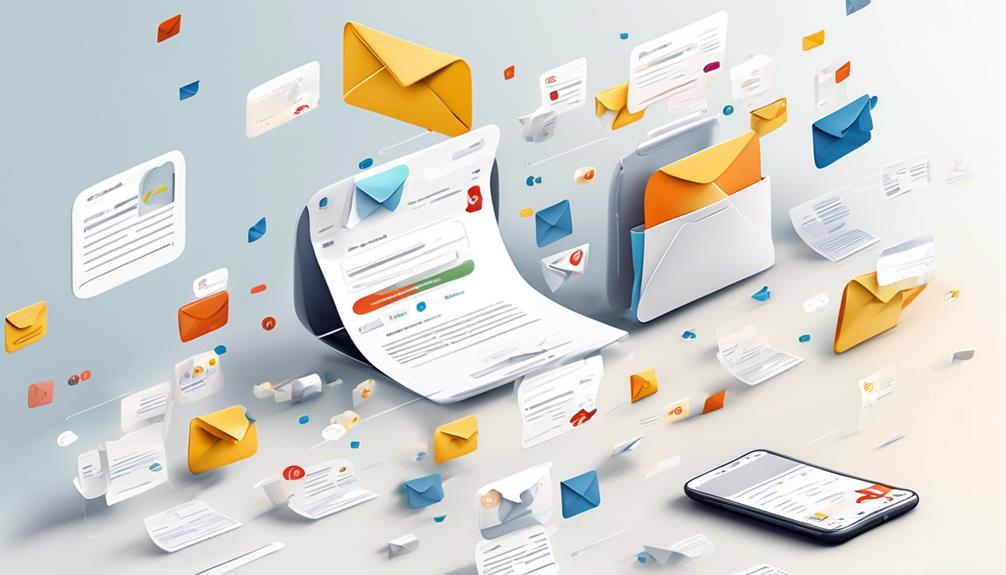
When it comes to personalizing emails, we've found that name personalization, content relevance, and timing and frequency are key best practices to focus on.
Personalizing the recipient's name in the subject line or opening greeting can significantly increase open rates.
Tailoring content to match the recipient's interests and sending emails at the right time can also boost engagement and conversion rates.
Name Personalization
- Incorporating the recipient's name into the email subject lines and content enhances personalization and improves engagement rates.
- Personalization increases open rates, click-through rates, and ultimately leads to higher transaction rates.
- When using the recipient's name in the subject line, it creates a sense of individualized attention, making the email more likely to be opened.
- Moreover, personalized messaging that includes the recipient's name makes the content feel more relevant and tailored to their needs, increasing the likelihood of conversion.
- By personalizing your emails with the recipient's name, you can significantly improve the overall effectiveness of your email marketing campaigns.
Content Relevance
To optimize content relevance in email personalization, it's essential to utilize a combination of dynamic content insertion, customized subject lines, and segmentation based on demographic and buyer's journey data.
Personalized emails with relevant content significantly impact open rates and engagement. By incorporating a personal touch and addressing subscribers by name, the subject line becomes more compelling, increasing the likelihood of the email being opened.
Dynamic content allows for tailored messaging, ensuring that the information provided aligns with the recipient's interests and needs. Effective segmentation based on demographic and buyer's journey data enables the delivery of personalized content, further enhancing the relevance of the email.
Continuously refining personalization techniques based on collected data is crucial for maintaining content relevance and maximizing email success rates.
Timing and Frequency
Understanding the recipient's behavior and preferences is crucial for personalizing the timing and frequency of emails to maximize engagement and response rates. When considering timing and frequency for personalized emails, it's essential to leverage segmentation to send more targeted content.
A/B testing can help determine the optimal send times and frequencies, leading to improved open rates. Utilizing marketing automation allows for the customization of email sending times based on recipient behavior, ensuring timely delivery. Additionally, crafting compelling subject lines aligned with the content and timing can significantly impact open rates.
By incorporating these best practices, we can enhance the effectiveness of personalized emails and drive better engagement and response rates.
- Utilize segmentation for targeted content.
- A/B testing to determine optimal send times and frequencies.
- Leverage marketing automation for personalized send times.
Common Personalization Mistakes
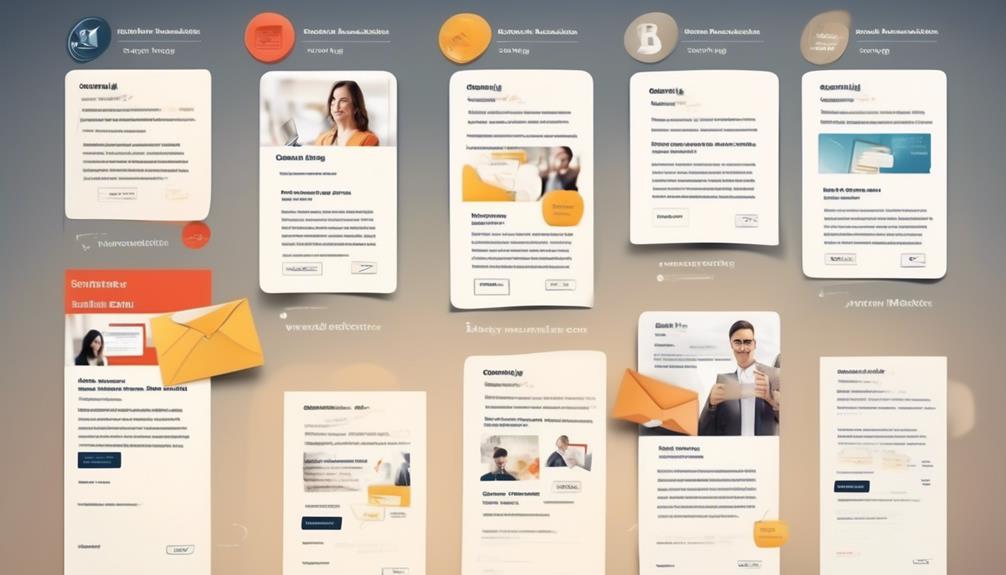
Common Personalization Mistakes Often Lead to Decreased Engagement and Negative Brand Perception. Personalized emails are meant to enhance the customer experience, but common mistakes can have the opposite effect.
Overpersonalization, such as using overly intimate details or referencing information that the recipient hasn't provided, can be intrusive or creepy, leading to decreased open rates and negative brand perception. It's crucial to ensure that the data used for personalization is accurate and up-to-date.
Incorrect personalization, such as addressing a recipient by the wrong name or referencing outdated information, can harm the brand's credibility and diminish the effectiveness of personalization efforts.
Ignoring user preferences is another common mistake. Failing to consider factors such as communication frequency or content preferences can result in disengagement. Additionally, bombarding recipients with excessive personal details can be overwhelming and lead to a negative perception of the brand.
Insufficient data validation is also a pitfall. If the data used for personalization isn't properly validated, it can result in embarrassing errors or, worse, harm brand credibility.
Incorporating these insights into segmentation, subject lines, content, and calls to action in email marketing can help avoid these common personalization mistakes and improve overall engagement and brand perception.
Strategies for Personalizing Emails
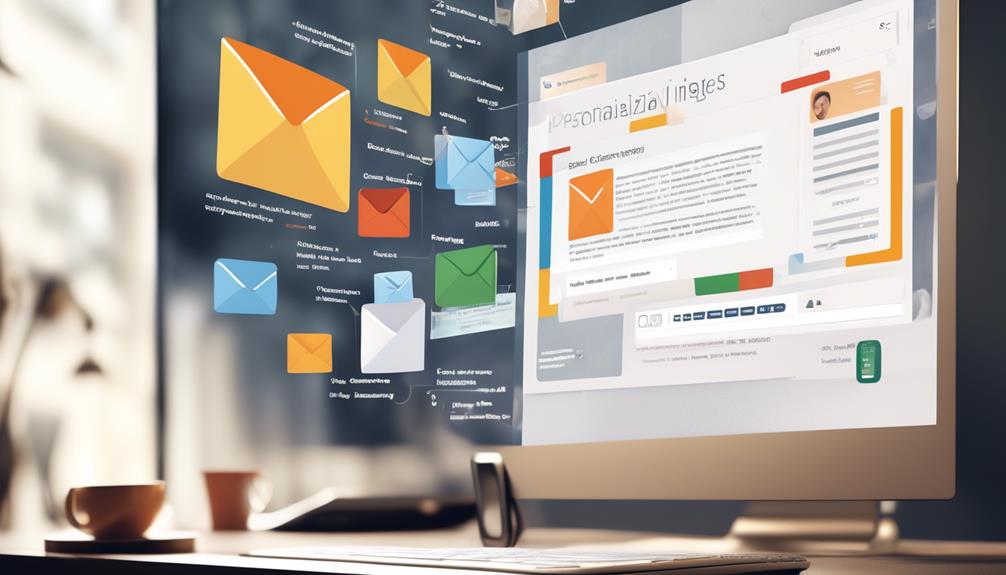
Implementing personalized email strategies is critical for engaging subscribers and enhancing the effectiveness of email marketing efforts. To achieve this, we recommend the following strategies for personalizing emails:
- Utilize the recipient's name in the subject line and email body for a personalized touch.
- Segment email lists based on demographics and the buyer's journey to target smaller segments with highly relevant content.
- Implement dynamic content insertion based on recipient data to create advanced personalization and increase open rates.
Impact on Email Open Rates

When it comes to achieving higher email open rates through personalization strategies, the impact of tailored content and segmented messaging can't be overstated.
Personalized emails, especially those with customized subject lines, have shown a significant impact on open rates. Studies indicate that using the recipient's name and demographics in email content can result in increased open rates.
Additionally, segmentation of email lists for targeted messaging has been proven to lead to higher open rates. It's also essential to note that dynamic content insertion based on recipient data can positively influence open rates. This highlights the importance of leveraging marketing software that enables dynamic content creation and audience segmentation for email campaigns.
The data unequivocally supports the notion that email personalization directly correlates with increased open rates. Incorporating these strategies into email marketing campaigns can lead to more impactful and engaging interactions with recipients, ultimately resulting in improved open rates and higher overall campaign success.
Effect on Click-Through Rates

When it comes to email personalization, the impact on click-through rates is significant.
Tailoring content to individual recipients' interests and preferences boosts engagement and drives higher conversion rates.
Including personalized product recommendations or special offers in emails has been shown to result in higher click-through rates.
Personalized Content Engagement
With personalized content engagement, click-through rates can be significantly improved, leading to greater success in email marketing campaigns.
When emails are personalized, open rates tend to be higher, indicating that recipients find the content more relevant and engaging.
Personalized subject lines have been shown to increase open rates and, consequently, click-through rates, as they capture the recipient's attention and entice them to explore the email further.
Additionally, personalized emails that address specific needs and preferences of the recipients are more likely to result in higher click rates, as the content resonates with the individual on a more personal level.
Impact on Conversion Rates
Personalized email content has a significant impact on conversion rates, directly influencing the click-through rates and overall engagement of recipients. By tailoring content to specific recipient needs, open rates and click-through rates can be significantly improved. Implementing highly personalized subject lines and using segmentation to target smaller segments of the audience have been shown to drive higher engagement and better conversion rates. According to marketing data, testing the impact of personalized content on click-through rates has consistently demonstrated the effectiveness of this approach in driving customer engagement. The table below illustrates the impact of personalized email content on conversion rates and click-through rates.
| Aspects of Personalized Emails | Impact on Conversion Rates |
|---|---|
| Dynamic Content Insertion | Higher conversion rates |
| Customized Subject Lines | Improved click-through rates |
| Demographics-based Segmentation | Better engagement |
| Highly Personalized Content | Increased conversion rates |
| Testing Strategies | Enhanced customer engagement |
Successful Personalization Examples
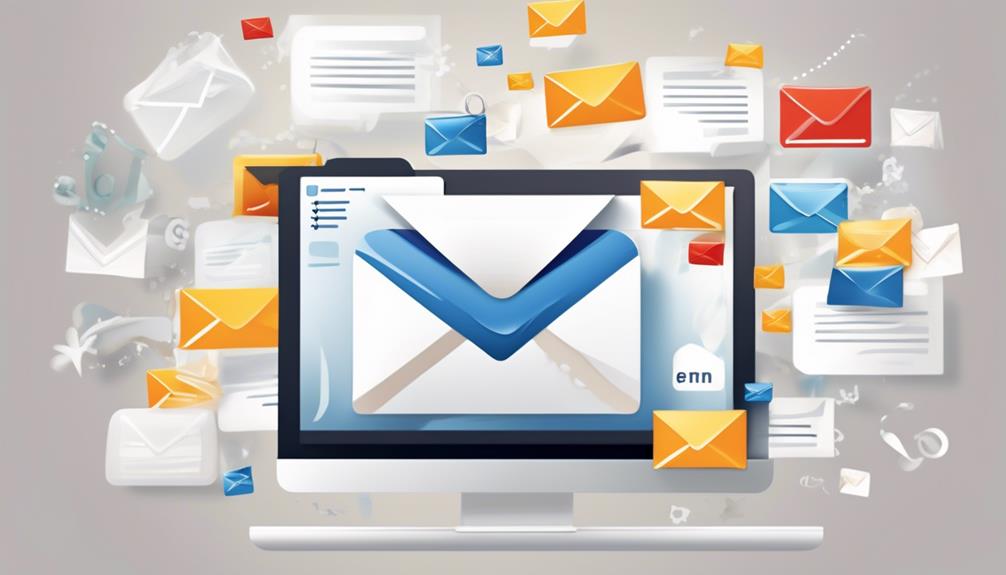
How do leading brands effectively personalize their email marketing campaigns to drive engagement and conversion rates?
Successful personalization examples include:
- Colored Organics creates highly personalized welcome emails with specialized discounts to increase open rates and drive conversions.
- Panera Bread delivers highly personalized emails by referencing recipients by name and targeting engaged subscribers, resulting in increased engagement and conversion rates.
- Bombas effectively uses clever imagery, copy, and incentives in their personalized emails to create a compelling and personalized experience for recipients, leading to higher engagement and conversion rates.
These brands have demonstrated the power of personalized emails in increasing open rates, driving engagement, and ultimately boosting conversion rates. By segmenting their audience and testing different personalized approaches, they've been able to deliver highly relevant content that resonates with their subscribers.
Small businesses can learn from these examples and incorporate personalization strategies into their email campaigns to enhance customer relationships and improve overall performance.
Role of Data in Personalization
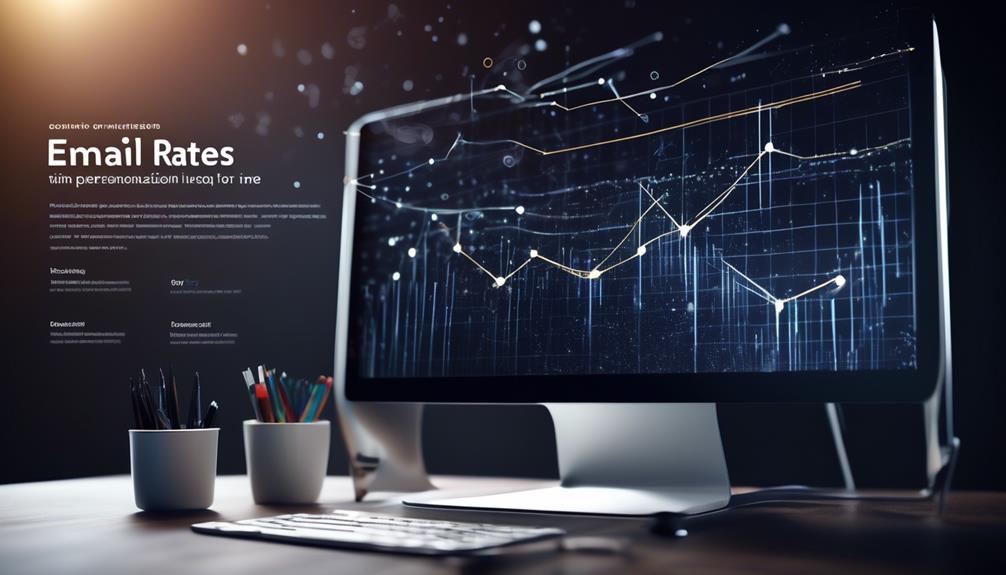
After showcasing successful personalization examples in email marketing, we now turn our focus to the pivotal role of data in tailoring messages to the interests, behaviors, and preferences of the target audience. Data plays a crucial role in email personalization, allowing businesses to create highly effective campaigns that increase email success rates. By leveraging data, businesses can segment their audience based on specific criteria, such as demographics, past behaviors, or purchase history. This segmentation enables personalized content that resonates with the recipient, leading to higher engagement and conversion rates.
| Data Role in Email Personalization | ||
|---|---|---|
| Provides Insights | Tailors Messages | Segmentation |
| Enables understanding of customer preferences | Delivers relevant content | Creates highly effective campaigns |
Analyzing data allows businesses to understand customer preferences and deliver relevant content. This understanding of customer preferences enables businesses to tailor their messages to the individual recipient, increasing the likelihood of the customer interacting with the email and taking the desired action. Therefore, the role of data in personalization is instrumental in driving the success of email marketing campaigns.
Measuring Personalized Email Success

Measuring the success of personalized email campaigns requires a comprehensive analysis of key performance indicators and engagement metrics. It's essential to gauge the impact of personalization on email success rates through various metrics. This allows us to understand the effectiveness of our personalized email strategies and make informed adjustments for better results.
Here are the key metrics to consider:
- Open Rates: Monitoring the percentage of recipients who open the email provides insights into the effectiveness of personalized subject lines and content. Higher open rates indicate that personalization is resonating with the audience.
- Click-Through Rates: Tracking the number of recipients who click on links within the personalized emails showcases the level of engagement and interest. It demonstrates whether the personalized content is compelling enough to encourage action.
- Unsubscribe Rates: Monitoring the rate at which recipients unsubscribe after receiving personalized emails is crucial. It helps in evaluating whether personalization is enhancing or detracting from the overall subscriber experience.
Future of Email Personalization

As we look ahead to the future of email personalization, our focus shifts towards leveraging emerging technologies and customer insights to enhance the impact of personalized email campaigns.
The future of email personalization is poised to be driven by advancements in artificial intelligence (AI) and machine learning, enabling marketers to create hyper-targeted and relevant content for their audiences. AI will play a crucial role in automating the process of segmentation and personalization, allowing for real-time adjustments based on user behavior and preferences.
Furthermore, the future of email personalization will also involve a deeper integration of customer data from various touchpoints, such as website interactions, social media engagement, and purchase history. This holistic approach to data collection and analysis will enable marketers to create highly personalized and timely email communications that resonate with individual recipients.
In addition, the future of personalized email will see the convergence of marketing efforts across multiple channels, creating a seamless and cohesive experience for the consumer. By aligning email personalization with broader marketing strategies, brands can ensure a consistent and personalized messaging approach across all customer touchpoints, ultimately driving improved email success rates.
Frequently Asked Questions
Are Personalized Emails More Effective?
Yes, personalized emails are more effective. They capture attention and boost engagement.
Basics include using the recipient's name and segmenting lists.
Dynamic content insertion, customized subject lines, and improved conversion rates are types of email personalization.
Best practices involve collecting relevant data, using personalization features, and continual refinement.
Overpersonalization, ignoring user preferences, and insufficient data validation are common mistakes to avoid.
What Are the Statistics of Personalization in Emails?
We've seen a significant impact from personalization in emails. Consumers are exclusively engaging with personalized messaging, and the stats speak for themselves.
Personalized emails achieve a 29% open rate and a 41% click-through rate, driving repeat buyers. Additionally, 49% prefer weekly promotional emails from favorite retail brands.
Without personalization, 52% of customers are willing to seek alternative shopping destinations. These statistics highlight the crucial role of personalization in email success.
Does Personalization Increase Open Rates?
Absolutely, personalization significantly boosts open rates.
By tailoring content to individual preferences and behaviors, we create a more engaging experience for our audience.
This fosters a stronger connection and increases the likelihood of recipients opening and engaging with our emails.
We've seen a notable increase in open rates since implementing personalization strategies, reinforcing the importance of this approach for email success.
What Is the Impact of Email Personalisation?
Personalization in email marketing has a significant impact on engagement and open rates. It captures attention and creates a more personalized experience for recipients. By utilizing the recipient's name, segmenting email lists, and sending timely, relevant content, we can boost engagement.
Dynamic content insertion, customized subject lines, and tailored content further enhance the impact. It's essential to collect relevant data, use personalization features, and analyze results to maximize the benefits.
How Can Personalization Impact Email Success Rates?
In today’s digital world, elevating email success with personalization is crucial. By tailoring content to individual recipients, you can improve open rates, click-through rates, and ultimately, conversion rates. Personalized emails create a more meaningful connection with the audience, leading to higher engagement and better overall success.
Conclusion
In conclusion, personalization is the key to unlocking email success. Did you know that personalized emails deliver 6x higher transaction rates?
Imagine the impact of connecting with your audience on a personal level and seeing your engagement and conversion rates skyrocket. By implementing thoughtful personalization strategies, we can create meaningful connections with our subscribers and drive impressive results for our email marketing campaigns.
The future of email personalization is bright, and the possibilities are endless.
